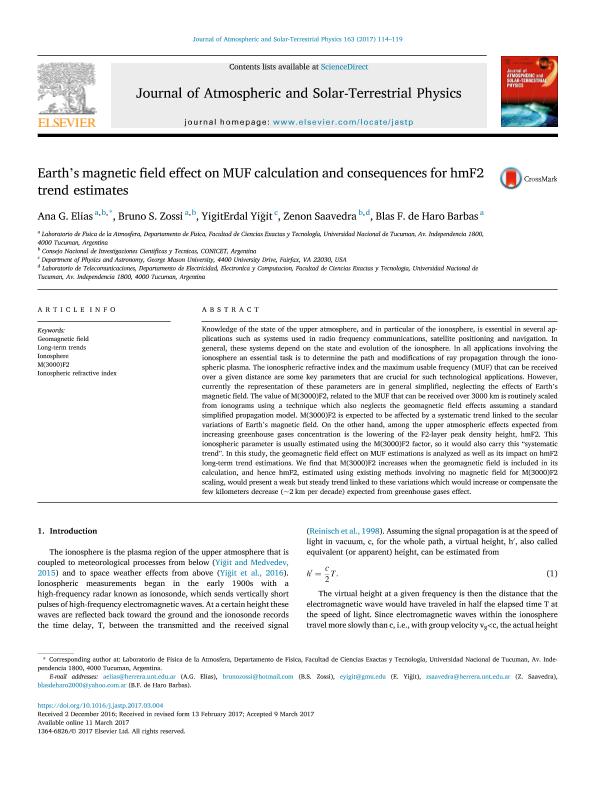Artículo
Earth's magnetic field effect on MUF calculation and consequences for hmF2 trend estimates
Elias, Ana Georgina ; Zossi, Bruno Santiago
; Zossi, Bruno Santiago ; Yigit, Erdal; Saavedra, Zenon
; Yigit, Erdal; Saavedra, Zenon ; de Haro Barbás, Blas Federico
; de Haro Barbás, Blas Federico
 ; Zossi, Bruno Santiago
; Zossi, Bruno Santiago ; Yigit, Erdal; Saavedra, Zenon
; Yigit, Erdal; Saavedra, Zenon ; de Haro Barbás, Blas Federico
; de Haro Barbás, Blas Federico
Fecha de publicación:
10/2017
Editorial:
Elsevier
Revista:
Journal of Atmospheric and Solar-Terrestrial Physics
ISSN:
1364-6826
Idioma:
Inglés
Tipo de recurso:
Artículo publicado
Clasificación temática:
Resumen
Knowledge of the state of the upper atmosphere, and in particular of the ionosphere, is essential in several applications such as systems used in radio frequency communications, satellite positioning and navigation. In general, these systems depend on the state and evolution of the ionosphere. In all applications involving the ionosphere an essential task is to determine the path and modifications of ray propagation through the ionospheric plasma. The ionospheric refractive index and the maximum usable frequency (MUF) that can be received over a given distance are some key parameters that are crucial for such technological applications. However, currently the representation of these parameters are in general simplified, neglecting the effects of Earth's magnetic field. The value of M(3000)F2, related to the MUF that can be received over 3000 km is routinely scaled from ionograms using a technique which also neglects the geomagnetic field effects assuming a standard simplified propagation model. M(3000)F2 is expected to be affected by a systematic trend linked to the secular variations of Earth's magnetic field. On the other hand, among the upper atmospheric effects expected from increasing greenhouse gases concentration is the lowering of the F2-layer peak density height, hmF2. This ionospheric parameter is usually estimated using the M(3000)F2 factor, so it would also carry this “systematic trend”. In this study, the geomagnetic field effect on MUF estimations is analyzed as well as its impact on hmF2 long-term trend estimations. We find that M(3000)F2 increases when the geomagnetic field is included in its calculation, and hence hmF2, estimated using existing methods involving no magnetic field for M(3000)F2 scaling, would present a weak but steady trend linked to these variations which would increase or compensate the few kilometers decrease (~2 km per decade) expected from greenhouse gases effect.
Archivos asociados
Licencia
Identificadores
Colecciones
Articulos(CCT - NOA SUR)
Articulos de CTRO.CIENTIFICO TECNOL.CONICET - NOA SUR
Articulos de CTRO.CIENTIFICO TECNOL.CONICET - NOA SUR
Citación
Elias, Ana Georgina; Zossi, Bruno Santiago; Yigit, Erdal; Saavedra, Zenon; de Haro Barbás, Blas Federico; Earth's magnetic field effect on MUF calculation and consequences for hmF2 trend estimates; Elsevier; Journal of Atmospheric and Solar-Terrestrial Physics; 163; 10-2017; 114-119
Compartir
Altmétricas



